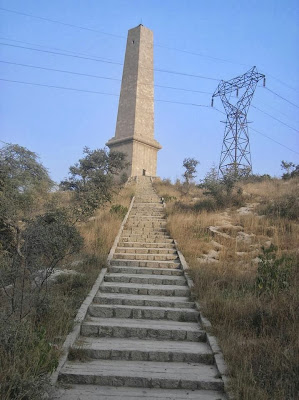THE OBELISK
Nicholson Monument
It was
sometimes way back in 1956, when I was only four years old that my father Brig
® Mohammad Alimuddin, a young captain at that time took me on our family picnic
to WAH GARDENS. At that time the
tall structure of the Nicholson Monument caught my attention as this tower
could be seen once you cross the railway crossing at TARNOL.
This majestic and awe aspiring structure had a particular attraction for me as I always wondered what was inside this structure. I had to wait till 1969, when I was a first year student at CADET COLLEGE HASSANABDAL that I got the opportunity to climb up to this structure and also go inside the tower and climb the stairs to the very top where a big window on all four sides giving a panoramic view of the foothills below. Nowadays the entrance to the inside of the tower is locked and crude barbed wires can be seen scaring the visitors away.
Many a times
I had to accompany guests from Karachi and other places for sightseeing visits
to TAXILA museum and the archeological excavation sights and Nicholson monument
became the first stop on my itinerary.
Lately
because of the sporadic vandalism and the mushrooming of stone crushing machines
that this structure has lost much of its old grandeur and attraction and now a
days it is engulfed in clouds of pollution debris coming from the stone
crushing machines which are found in abundance in the area as they are slowly
eating away the solid mountains around and are creating an ecological disaster
to which the authorities are turning a deaf ear.
About a
few years back when I started writing for ecological tourism wonders of
Pakistan I made it a point to visit this place a fresh and to bring to the
readers the importance of this significant landmark of Rawalpindi and
Islamabad.
This structure erected in1868 is a granite obelisk in honor of Brig Gen John Nicholson's who led the assault of Delhi but fell in the hour of victory mortally wounded at this place. Two structures are located at the foot of Margalla pass and in the shadow of Nicholson's obelisk. They are reproductions of classical Greek buildings. The Legendary warrior King, Alexander the Great had passed through this area about 325 BC on his way to Indian conquest and stayed at TAXILA, 8 km from the obelisk. The ruins of original Grand Trunk road leading to Afghanistan which is in a semi preserved condition can also be seen in the area below the monument.
Nicholson monument stands out like a solitary sentinel atop the left side of the MARGALLAH pass as you go towards TAXILLA bearing the hall mark of the site where Sir John Nicholson was fatally wounded and died on 23rd September 1857 aged 34 years by a local known as Kala Khan.
The local story goes and is documented that one of the ancestors of SARDAR SIKANDAR HAYAT rescued the wounded Sir John Nicholson and brought him to the safety of WAH GARDENS and tried to tend to his wounds and look after him. Sir John Nicholson very much moved by the hospitality and nursing care extended to him that he before his dying breath doled out a big JAGEER (estate) to the ancestor of Sardar Sikandar Hayat. Sir Gen John Nicholson was buried in Nicholson cemetery in Kashmir gate in New Delhi where a statue was erected in his honor showing him holding a naked sword.
In the
beginning before the 1965 war the MARGALLAH pass was a narrow lane on the left
side of which there was a big cistern of water fed from the springs and on top
of that was the marble plaque commemorating and narrating the site where Sir
John Nicholson fell also there were a small fish tanks on the right side of the
road with shady trees where travelers could rest and small SARAIS (Inn) were
the travelers could stay and pass the night. These structures were ruthlessly
dismantled by the highway authorities in the name of progress.
When MARGALLAH
pass was widened in the 70’s the commemorative plaque was taken down and moved
to the TAXILLA museum where as the water cistern can be seen on the right side
of the road housed in a Greek style structure but no water comes in to the
cistern.
One lone
solitary board is there telling the tourist about the site of the grand trunk
road and a portion of that road through which Alexander the great passed can
still be seen and clearly distinguished by its cobble stone pavement which can
be compared to the Champs Elyse street of Paris. One addition seen by me lately
is the construction of the steps from the bottom to the top of the monument
which makes it easier for the tourists to climb to the top.
The need
of hour is that this tourist attraction must be saved from ruin and vandalism
and taken over by responsible caretakers. Small children play area, chairs for
seating, mini restaurant and nicely maintained garden should be added so that
the future generations can benefit from the legacy left behind by our elders.
DR. BABUR ZAHIRUDDIN















Dear Babur Sahib,
ReplyDeleteYou are confusing something about the story of John Nicholson. He was wounded during the final assault on Delhi on 13th September, 1857 and died ten days later. He is buried near the Kashmiri gate and his grave still can be seen there. So story of wounding at this place and being carried to Wah, makes no sense. Please read some book about the mutiny to make yourself clear on this subject. Don't ever believe gossips, our people have no interest in history. Though they love to make bull and cock stories.
tariqamir1015@gmail.com